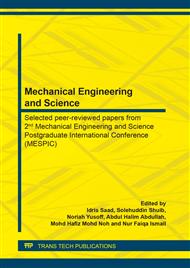[1]
A. T. El-sera, I. T. El-sera, and M. Elmasry, Skin regeneration in three dimensions , current status , challenges and opportunities,, vol. 96, no. March, p.26–29, (2017).
DOI: 10.1016/j.diff.2017.06.002
Google Scholar
[2]
N. F. A. Manan and J. Mahmud, The effect of skin orientation on biomechanical,, J. Mech. Eng., vol. 12, no. 1, p.67–81, (2015).
Google Scholar
[3]
Y. Tu et al., Preparation and characterization of thermosensitive artificial skin with a Sandwich structure,, Mater. Lett., vol. 147, p.4–7, (2015).
Google Scholar
[4]
M. Nachman and S. E. Franklin, Artificial Skin Model simulating dry and moist in vivo human skin friction and deformation behaviour,, Tribol. Int., vol. 97, p.431–439, (2016).
DOI: 10.1016/j.triboint.2016.01.043
Google Scholar
[5]
T. Agarwal et al., Gelatin/Carboxymethyl chitosan based scaffolds for dermal tissue engineering applications,, Int. J. Biol. Macromol., vol. 93, p.1499–1506, (2016).
Google Scholar
[6]
F. Gottrup, M. Agren, and T. Karlsmark, 24 Wound Healing,, (2000).
Google Scholar
[7]
D. Hellio and M. Djabourov, Chemically and Physically Cross-linked Gelatin Gels.,.
Google Scholar
[8]
F. Fathi, J. Ezzati Nazhad Dolatanbadi, M.-R. Rashidi, and Y. Omidi, Kinetic studies of bovine serum albumin interaction with PG and TBHQ using surface plasmon resonance,, Int. J. Biol. Macromol., vol. 91, p.1045–1050, (2016).
DOI: 10.1016/j.ijbiomac.2016.06.054
Google Scholar
[9]
J. Y. Kim, S. B. Ryu, and K. D. Park, Journal of Industrial and Engineering Chemistry Preparation and characterization of dual-crosslinked gelatin hydrogel via Dopa-Fe 3 + complexation and fenton reaction,, J. Ind. Eng. Chem., p.1–8, (2017).
DOI: 10.1016/j.jiec.2017.09.014
Google Scholar
[10]
M. Singh, K. Nuutila, K. C. Collins, and A. Huang, ScienceDirect Evolution of skin grafting for treatment of burns : Reverdin pinch grafting to Tanner mesh grafting and beyond,, Burns, vol. 43, no. 6, p.1149–1154, (2017).
DOI: 10.1016/j.burns.2017.01.015
Google Scholar
[11]
G. Salgado, Y. Z. Ng, L. F. Koh, C. S. M. Goh, and J. E. Common, Human reconstructed skin xenografts on mice to model skin physiology,, Differentiation, vol. 98, no. September, p.14–24, (2017).
DOI: 10.1016/j.diff.2017.09.004
Google Scholar
[12]
B. Li, V. Rama, L. Preethi, and M. S. H. Fatt, Predicting failure in rubber membranes : An experimental- numerical approach,, vol. 90, no. January, p.404–424, (2018).
DOI: 10.1016/j.engfailanal.2018.04.003
Google Scholar
[13]
S. Ding and B. Bhushan, Journal of Colloid and Interface Science Tactile perception of skin and skin cream by friction induced vibrations,, J. Colloid Interface Sci., vol. 481, p.131–143, (2016).
DOI: 10.1016/j.jcis.2016.07.034
Google Scholar
[14]
N. Kumaraswamy, H. Khatam, G. P. Reece, and M. C. Fingeret, Journal of the Mechanical Behavior of Biomedical Materials Mechanical response of human female breast skin under uniaxial stretching,, J. Mech. Behav. Biomed. Mater., vol. 74, no. May, p.164–175, (2017).
DOI: 10.1016/j.jmbbm.2017.05.027
Google Scholar
[15]
K. B. Putra, J. Plott, and A. J. Shih, Biaxial Mooney-Rivlin coefficient of silicone sheet by additive manufacturing,, Procedia CIRP, vol. 65, p.189–195, (2017).
DOI: 10.1016/j.procir.2017.04.049
Google Scholar
[16]
R. M. Soares and P. B. Gonçalves, Large-amplitude nonlinear vibrations of a Mooney – Rivlin rectangular membrane,, J. Sound Vib., vol. 333, no. 13, p.2920–2935, (2014).
DOI: 10.1016/j.jsv.2014.02.007
Google Scholar
[17]
C. Renaud, J. Cros, Z. Feng, and B. Yang, International Journal of Impact Engineering The Yeoh model applied to the modeling of large deformation contact / impact problems,, Int. J. Impact Eng., vol. 36, no. 5, p.659–666, (2009).
DOI: 10.1016/j.ijimpeng.2008.09.008
Google Scholar
[18]
M. Gajewski, Modelling of elastomeric bearings with application of Yeoh hyperelastic material model,, vol. 111, no. TFoCE, p.220–227, (2015).
DOI: 10.1016/j.proeng.2015.07.080
Google Scholar
[19]
N. F. A. Manan, Aziz, A.H.A., J. Mahmud, and A. H. Abdullah, Analysis of dryness effect on skin by adapting hyperelastic constitutive model,, (2018).
Google Scholar


